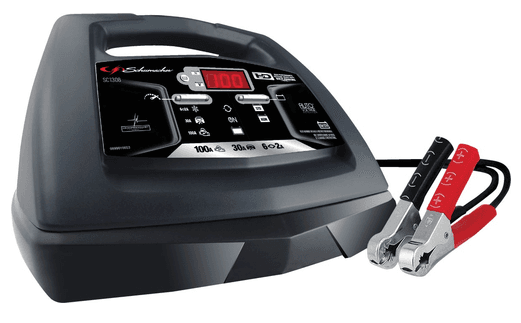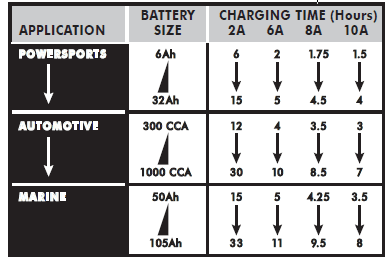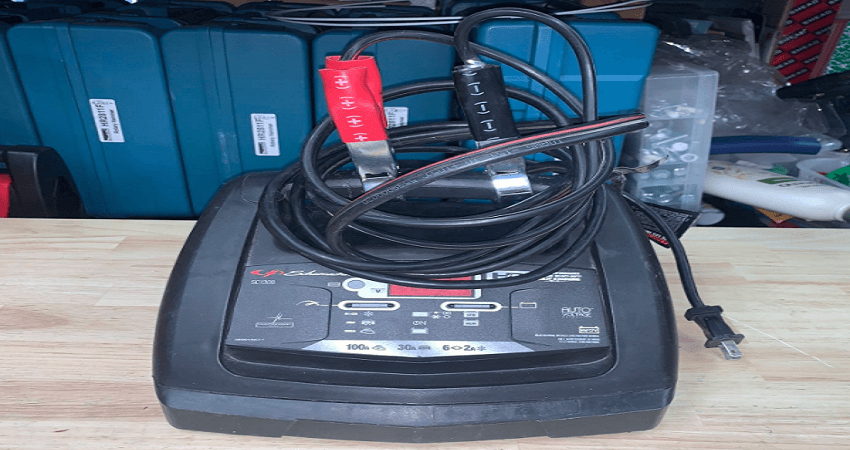
Schumacher SC1308 Automatic Battery Charger Starter

PREPARING TO CHARGE
- If necessary remove the battery from the vehicle to charge, always remove the grounded terminal from the battery first. Make sure all accessories in the vehicle are off, so as not to cause an arc.
- Be sure the area around the battery is well-ventilated while the battery is being charged.
- Clean battery terminals. Be careful to keep corrosion from coming in contact with eyes.
- Add distilled water in each cell until battery acid reaches the level specified by the manufacturer. Do not overfill. For a battery without removable cell caps, such as valve-regulated lead acid batteries, carefully follow the manufacturer’s recharging instructions.
- Study all battery manufacturer’s specific precautions while charging and recommended rates of charge.
- Determine the voltage of the battery by referring to the car owner’s manual and make sure that the output voltage selector switch is set at the correct voltage. If the charger has an adjustable charge rate, charge the battery initially at the lowest rate.
CHARGER LOCATION
- Locate the charger as far away from the battery as DC cables permit.
- Never place the charger directly above battery being charged; gases from the battery will corrode and damage the charger.
- Never allow battery acid to drip on the charger when reading electrolyte-specific gravity or filling the battery.
- Do not operate the charger in a closed-in area or restrict ventilation in any way.
- Do not set a battery on top of the charger.
DC CONNECTION PRECAUTIONS
- Connect and disconnect DC output clips only after setting any charger switches to the “off” position and removing the AC cord from an electric outlet. Never allow clips to touch each other.
- Attach clips to the battery and chassis, as indicated in sections 6 and 7.
FOLLOW THESE STEPS WHEN THE BATTERY IS INSTALLED IN THE VEHICLE
- Position AC and DC cords to reduce the risk of damage by the hood, door, or moving engine part.
- Stay clear of fan blades, belts, pulleys, and other parts that can cause injury to persons.
- Check the polarity of battery posts. POSITIVE (POS, P, +) battery post usually has a larger diameter than NEGATIVE (NEG, N,–) post.
- Determine which post of the battery is grounded (connected) to the chassis. If the negative post is grounded to the chassis (as in most vehicles), see (6.5). If a positive post is grounded to the chassis, see (6.6).
- For negative-grounded vehicles, connect the POSITIVE (RED) clip from the battery charger to the POSITIVE (POS, P, +) ungrounded post of the battery. Connect a NEGATIVE (BLACK) clip to the vehicle chassis or engine block away from the battery. Do not connect the clip to the carburetor, fuel lines, or sheet-metal body parts. Connect to a heavy gauge metal part of the frame or engine block.
- For a positive-grounded vehicle, connect the NEGATIVE (BLACK) clip from the battery charger to the NEGATIVE (NEG, N, –) ungrounded post of the battery. Connect POSITIVE (RED) clip to vehicle chassis or engine block away from battery. Do not connect the clip to the carburetor, fuel lines, or sheet-metal body parts. Connect to a heavy gauge metal part of the frame or engine block.
- When disconnecting the charger, turn the switches off, disconnect the AC cord, remove the clip from the vehicle chassis, and then remove the clip from the battery terminal.
- See Operating Instructions for length of charge information.
FOLLOW THESE STEPS WHEN THE BATTERY IS OUTSIDE THE VEHICLE
- Check the polarity of battery posts. POSITIVE (POS, P, +) battery post usually has a larger diameter than NEGATIVE (NEG, N, –) post.
- Attach at least a 24-inch long 6-gauge (AWG) insulated battery cable to NEGATIVE (NEG, N, –) battery post.
- Connect the POSITIVE (RED) charger clip to the POSITIVE (POS, P, +) post of the battery.
- Position yourself and the free end of the cable as far away from the battery as possible then connect a NEGATIVE (BLACK) charger clip to the free end of the cable.
- Do not face the battery when making the final connection.
- When disconnecting the charger, always do so in reverse sequence of the connecting procedure and break the first connection while as far away from the battery as practical.
- A marine (boat) battery must be removed and charged on shore. To charge it on board requires equipment specially designed for marine use.
GROUNDING AND AC POWER CORD CONNECTIONS
- This battery charger is for use on a nominal 120-volt circuit. The charger must be grounded, to reduce the risk of electric shock. The plug must be plugged into an outlet that is properly installed and grounded following all local codes and ordinances. The plug pins must fit the receptacle (outlet). Do not use an ungrounded system.
- DANGER: Never alter the AC cord or plug provided – if it does not fit the outlet, have a properly grounded outlet installed by a qualified electrician. An improper connection can result in a risk of an electric shock or electrocution. NOTE: Under Canadian Regulations, the use of an adapter plug is not allowed in Canada. Use of an adapter plug in the United States is not recommended and should not be used.
- USING AN EXTENSION CORD
The use of an extension cord is not recommended. If you must use an extension cord, follow these guidelines: - Pins on the plug of the extension cord must be the same number, size, and shape as those of the plug-on charger.
- Ensure that the extension cord is properly wired and in good electrical condition.
- Wire size must be large enough for the AC ampere rating of the charger, as specified:
Length of cord (feet) 25 50 100 150 AWG* size of the cord 16 14 14 12
ASSEMBLY INSTRUCTIONS
- Remove all cord wraps and uncoil the cables before using the battery charger.
- Included with your charger are two cord wrap cleats for storage of the clamp cables. To install, align the two tabs with the two receptacles on the back of the charger and push until you hear a snap.
CONTROL PANEL
DIGITAL DISPLAY
The Digital Display gives a digital indication of voltage or % of charge. The display will show the battery VOLTAGE when the charger is not charging a battery. When it goes into charging mode, the display will automatically change to ON (to show charging has started) and then show the percent-of-charge of the battery being charged and either 6 or 12 (the battery voltage determined by the charger). If you manually stop the charging process (by pressing the Rate Selection button) before the battery is fully charged, the display will show OFF.
- DISPLAY BUTTON
Use this button to set the function of the digital display to one of the following: - (Battery %) – The digital display shows an estimated charge percentage of the battery connected to the charger’s battery clamps.
- (Voltage) – The Digital Display shows the voltage at the charger battery clamps, in DC volts.
- RATE SELECTION BUTTON
Use this button to select one of the following: - 6<>2A CHARGE/MAINTAIN – For charging small and large batteries. Not recommended for industrial applications.
- 30A BOOST – For quickly adding energy to a severely discharged or large-capacity battery before the Engine starts.
- 100A ENGINE START – Provides additional amps for cranking an engine with a weak or run-down battery. Always use it in combination with a battery.
CHARGING A BATTERY IN THE VEHICLE
- Turn off all the vehicle’s accessories.
- Keep the hood open.
- Clean the battery terminals.
- Place the charger on a dry, non-flammable surface.
- Lay the AC/DC cables away from any fan blades, belts, pulleys, and other moving parts.
- Connect the battery, following the precautions listed in sections 6 and 7.
- Connect the charger to an electrical outlet.
- Select the battery type and desired rate.
- When charging is complete, disconnect the charger from the AC power, remove the clamps from the vehicle’s chassis, and then remove the clamp from the battery terminal.
CHARGING A BATTERY OUTSIDE OF THE VEHICLE
- Place the battery in a well-ventilated area.
- Clean the battery terminals.
- Connect the battery, following the precautions listed in sections 6 and 7.
- Connect the charger to the electrical outlet.
- Select the battery type and desired rate.
- When charging is complete, disconnect the charger from the AC power, disconnect the negative clamp, and finally the positive clamp.
- A marine (boat) battery must be removed and charged on shore.
BOOST MODE
To select the Boost mode, press the Rate Selection button until the yellow/ orange 30A Boost LED lights are solid. The LED will light solid if the battery is properly connected and the boosting process will start. While in Boost mode, the display will show the voltage. If a bad battery is detected, the display will show![]() an error code.
an error code.
CHARGE/MAINTAIN MODE
To select this mode, press the Rate Selection button until the yellow/orange 6<>2A Charge/Maintain LED lights. The LED will light solid if the battery is properly connected and the charging process will start. The display will show the charger voltage. To change the mode on the display, press the Display button. When the battery is fully charged, the green Charged/ Maintaining LED will light. If charging cannot be completed, the display will show![]() an error code. The battery may be bad; have it checked.
an error code. The battery may be bad; have it checked.
AUTOMATIC CHARGING MODE
When an Automatic Charge is performed, the charger switches to the maintain mode automatically after the battery is charged.
ABORTED CHARGE
If charging cannot be completed normally, charging will abort. When charging aborts, the charger’s output is shut off and the display will show ![]() an error code. Do not continue attempting to charge this battery. Check the battery and replace, it if necessary.
an error code. Do not continue attempting to charge this battery. Check the battery and replace, it if necessary.
DESULFATION MODE
The display will show “SUL” when a sulfated battery is detected, and the charger will go into desulfation mode. If the desulfation is not successful after 10 hours, the charger will go into abort mode. The display will show “bAd / bAt / F02”.
COMPLETION OF CHARGE
Charge completion is indicated by the green Charged/Maintaining LED. When lit, the charger has switched to the maintain mode of operation.
MAINTAIN MODE (FLOAT MODE MONITORING)
When the green Charged/Maintaining LED is lit, the charger has started to maintain mode. In this mode, the charger keeps the battery fully charged by delivering a small current when necessary. If the charger has to provide its maximum maintain current for a continuous 12-hour period, it will go into abort mode (see Aborted Charge section). This is usually caused by a drain on the battery or the battery could be bad.
MAINTAINING A BATTERY
The SC1308 charges and maintains both 6V and 12V batteries.
BATTERY CHARGING TIMES
 Times are based on a 50% discharged battery and may change, depending on the age and condition of the battery.
Times are based on a 50% discharged battery and may change, depending on the age and condition of the battery.
USING THE ENGINE START FEATURE
Your battery charger can be used to jump-start your car if the battery is low. Follow all safety instructions and precautions for charging your battery. Wear complete eye protection and protective clothing.
USING THE BATTERY VOLTAGE TESTER
- With the charger unplugged from the AC outlet, connect the charger to the battery, following the instructions given in previous sections.
- Plug the charger AC power cord into the AC outlet.
- Press the Battery Type button until the correct type is indicated.
- Read in the voltage on the digital display. Keep in mind that this reading is only a battery voltage reading; a false surface charge may mislead you. Compare the reading to the following chart.
6V Battery Voltage Reading 12V Battery Voltage Reading Battery Condition 6.4 or more 12.8 or more Charged 6.1 to 6.3 12.2 to 12.7 Needs charging Less than 6.1 Less than 12.2 Discharged
USING THE ALTERNATOR PERFORMANCE TESTER
- With the charger unplugged from the AC outlet, connect the charger to the battery, following the instructions given in previous sections.
- Plug the charger AC power cord into the AC outlet.
- Start the vehicle, rev the engine at 2000 rpm for 30 seconds, and turn on the vehicle’s headlights or other accessories.
- Read the voltage on the digital display. If you get a reading between 13.4 volts and 14.6 volts, the alternator is working properly. If the reading is less than 13.4 volts or more than 14.6 volts, refer to your vehicle’s manual or have the charging system checked by a qualified technician.
TROUBLESHOOTING AND ERROR CODES
Error Codes
| CODE | DESCRIPTION | REASON/SOLUTION |
| bAd bAT F01 | The battery voltage is still under 10V (for a 12V battery) or 5V (for a 6V battery) after 2 hours of charging. | The battery could be bad. Have it checked or replaced. |
| SUL | The charger has detected a sulfated battery. | The charger will go into desulfation mode. If the desulfation is not successful after 10 hours, the charger will go into abort mode. |
| bAd bAT F02 | The charger cannot desulfate the battery. | The battery could not be desulfated; have it checked or replaced. |
| bAd bAT F03 | The battery was unable to reach the “full charge” voltage. | May be caused by trying to charge a large battery or bank of batteries on too low of a current setting. Try again with a higher current setting or have the battery checked or replaced. |
| F04 | The connections to the battery are reversed. | The battery is connected backwards. Unplug the charger and reverse the connections to the battery. |
| bAd bAT F05 | The charger was unable to keep the battery fully charged in maintain mode. | The battery won’t hold a charge. May be caused by a drain on the battery or the battery could be bad. Make sure there are no loads on the battery. If there are remove them. If there are none, have the battery checked or replaced. |
| bAd bAT F06 | The charger detected that the battery may be getting too hot (thermal runaway). | The charger automatically shuts the current off if it detects the battery may be getting too hot. Have the battery checked or replaced. |
Troubleshooting
| PROBLEM | POSSIBLE CAUSE | SOLUTION |
| Battery clamps do not spark when touched together. | The charger is equipped with an auto-start feature. It will not supply current to the battery clamps until a battery is properly connected. The clamps will not spark if touched together. | No problem; this is a normal condition. |
| The charger will not turn on when properly connected. | AC outlet is dead.
Poor electrical connection. | Check for an open fuse or circuit breaker supplying the AC outlet.
Check the power cord and extension cord for loose-fitting plugs. |
For more manuals by Schumacher visit, ManualsLibraryy
Schumacher SC1308 Automatic Battery Charger Starter-FAQs
What settings should I use on my Schumacher battery charger?
Select the appropriate setting based on your battery type: Standard, AGM, Gel, or Lithium. If you’re unsure, choose the Gel setting, as it’s safe for most battery types.
How long does a Schumacher battery charger take to charge a battery?
The 6 Amp medium charge mode typically takes 6 to 8 hours to charge. The 2 Amp trickle charge mode is slower and can take 2 to 12 hours, depending on the battery size.
How can I check the status of my battery charge?
Open your phone’s Settings app, go to the Battery section, and see how much charge is left and how long it will last. You can also tap “Battery usage” for more details.
What does the red light mean on my Schumacher battery charger?
The red light indicates that the battery is fully charged. It may blink intermittently as the battery charge level fluctuates.
How do I know when my battery is fully charged?
Most chargers turn off automatically or display an indicator light when fully charged. If your charger lacks these features, refer to the manual for further guidance.
What is the best amp setting for a battery charger?
For safe and effective charging, slow charging (2-10 amps) is recommended. It’s often the best method for charging car batteries without overloading.
Why is the green light blinking on my Schumacher battery charger?
A blinking green light means the battery is currently charging. The light will turn solid green once the battery is fully charged, usually within 1-2 hours, depending on the battery’s discharge level.
Should I charge my battery at 2 or 10 amps?
For smaller batteries like those in motorcycles or lawnmowers, use the 2-amp setting to avoid potential safety issues. Check your battery specifications for the ideal charge rate.

